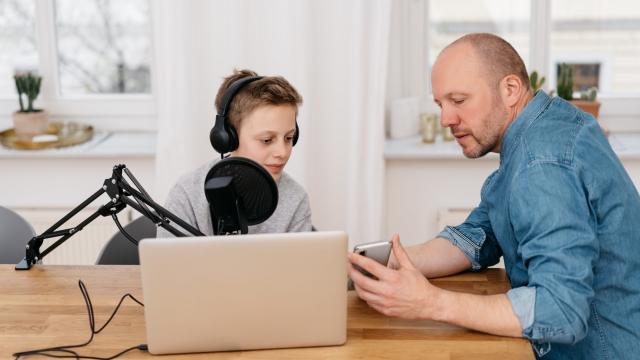Seven years ago, Nick Pavlidis was talking about podcasting at the dinner table, piquing the interest of his son Pavlos, then four years old. “I explained to him that it’s like a radio show but on the computer,” Pavlidis says. “Podcasting was still relatively in its infancy then. He said, ‘Oh. Can I have one?’” And that’s how the Five Minutes With Dad podcast was born.
In the years since, Pavlidis has released 200 episodes with his son Nick and daughter Angela, who are now 11 and nine.
“It has been an incredible experience, having this audio journal of my kids from four and two [years old] to 11 and nine years old,” he says. “It is really cool to listen back at some of our really fun conversations.”
Getting started is easier than you think
Five Minutes with Dad has built a regular audience thanks to the Pavlidis’ longtime consistency recording new episodes on topics that are relevant to all families. And getting started creating a podcast with kids can be as simple as that — starting. The only real requirements are a computer and a USB microphone. You’ll also need audio-editing software — and there are free options for that, like Audacity.
Consistency in how often you record and release episodes is also important, so that as you find an audience, they know when to expect new content. When working with kids, Pavlidis also recommends keeping things short.
“The reason it’s Five Minutes with Dad and not 45 Minutes with Dad is because it took a good hour of recording to get five minutes of useful audio when we first started,” he says. “Don’t worry too much about perfection. Get started, go live, and over time, you’ll improve significantly and you’ll really get to have some conversations with your kids about what matters to them. You learn a lot about them.”
The editorial side
Empowering kids with the ability to come up with topics, so they feel an ownership stake, is also important. Topics on Five Minutes with Dad include how to help in your community, how to choose a pet, letting go of things you can’t control, being a role model, learning outside of school, and more. Those topics are big in nature, and that’s by design. Pavlidis says the theme of the podcast is personal growth and leadership for kids. Within that framework, the ideas and topics originate from Pavlos and Angela.
“I let my kids run with most of the creative control of the show,” Pavlidis says. “They drive the topics. I would encourage parents to be the structure of the show, but let your kids run with the creative control because it keeps their interest and gets them excited and creates those opportunities to really make magic happen.”
Letting the kids set the editorial direction has made for good content, but it has also helped Pavlidis learn new things about his kids. In the midst of on-mic conversations on a specific topic, they’ll often use examples or share details from their friendships or other aspects of their lives.
“My daughter or my son will give me context or things they’re feeling on the subjects we’re talking about, [or] instances or examples of things [they’ve experienced at] school with their friends,” he says. “I learn a lot of really cool things about what they’re feeling or what they’re up to on the show, but it also helps listeners start to have those conversations [with their own kids], or make it more comfortable to have important conversations.”
The show has also served as an important outlet as Pavlos and Angela have adjusted to the drastic changes in their lives during the pandemic. Pavlidis says recording episodes has also helped them all remember to simply slow down and talk.
“Sometimes in the busyness of online learning or just getting through the days, you don’t take that pause to have deep conversations,” he says. “It’s helped to have some really positive conversations between me and them that alleviated some of their stress around the pandemic.”
The business side
Pavlidis uses the show to teach other valuable lessons though, too. He pays Pavlos and Angela $10 per episode each, which then they break down into smaller categories: $2 goes into giving, $3 into savings, $2 into investing, and $3 for spending money.
“Now, if they want something that costs $11 or $13, they don’t ask me for the money, they’ll say, ‘Dad, can we record two podcasts?,’” he says. “I use the podcast as a parenting tool to teach other lessons that are important. It’s not just about the show, but how we can use the show to reinforce important principles that I want my kids to grow up knowing.”
Several services, free and paid, are available to host podcasts and allow listeners to download episodes once you start recording. Platforms vary, and some have limitations on file sizes or numbers of downloads they’ll allow. Popular choices include Podbean, BuzzSprout, Anchor, Spreaker, and Transistor, but those are just a handful of the many options.
Chiefly, Pavlidis recommends getting over the idea of needing to be perfect or trying to build an audience right off the bat. Just dive in and get started.
“It’s so worth it, even if no one [else] listens,” Pavlidis says. “We’ve been blessed to build some downloads and a following; it really tugs on my heart, but even if that didn’t exist, it’s worth it just to have those moments with the kids.”

Leave a Reply
You must be logged in to post a comment.